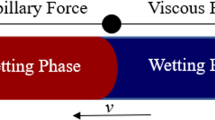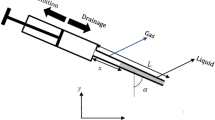Abstract
Effectively mobilizing displacement and predicting mobilization pressure in a porous-type reservoir filled with bubbles or blobs require the knowledge of variation of contact angles and capillary pressure. A bubble/blob has two interfaces and thus has two contact angles. It has been found that double interfaces cause resistance to displacement, and the resisting pressure rises while one contact angle increasing and the other decreasing during mobilization. To quantitatively explain how the resistance to flow builds up according to the contact angle variations during mobilization, it is assumed that (1) contact points remain unmoved; (2) the volume of a bubble or blob maintains constant; (3) once the interface starts moving at low capillary number, the contact angle remains to be the advancing or receding angle; (4) the viscous effect on pressure drop can be ignored; and (5) the two angles of two interfaces are equal to an equilibrium angle at the initiation of mobilization. A theoretical model is developed based on these assumptions, and the quantitative relationship of the two angles is expressed by an implicit function. Combining Young–Laplace equation, the capillary pressure induced by double interfaces is obtained. The model’s prediction is in good agreement with experiments in studies. The equilibrium angle has strong influence on the variation of the two angles. When the equilibrium angle is less than 90 degrees, a relatively greater change in the contact angle at the advancing interface leads to a smaller change in the other one. Otherwise, the opposite is true. The changes of the two angles are equal when the equilibrium angle is 90 degrees. Moreover, a linear trend proposed by a previous investigation is incorporated into the model, to predict the ending of mobilization stage and to predict the maximum mobilization pressure on a given solid surface.










Similar content being viewed by others
References
Bonn, D., Eggers, J., Indekeu, J., Meunier, J., Rolley, E.: Wetting and spreading. Rev. Mod. Phys. 81(2), 739–805 (2009). https://doi.org/10.1103/RevModPhys.81.739
Bora, R., Maini, B.B., Chakma, A.: Flow visualization studies of solution gas drive process in heavy oil reservoirs with a glass micromodel. SPE Reserv. Eval. Eng. 3(3), 224–229 (2000)
Chen, H., Amirfazli, A., Tang, T.: Modeling liquid bridge between surfaces with contact angle hysteresis. Langmuir 29(10), 3310–3319 (2013). https://doi.org/10.1021/la304870h
Gardescu, I.I.: Behavior of gas bubbles in capillary spaces. Trans. Am. Inst. Min. Met. Eng. 86, 351–370 (1930). https://doi.org/10.2118/930351-G
Hsu, S.Y., Glantz, R., Hilpert, M.: Pore-scale analysis of the effects of contact angle hysteresis on blob mobilisation in a pore doublet. Int. J. Oil Gas Coal Technol. 5(2/3), 207 (2012). https://doi.org/10.1504/ijogct.2012.046321
Hsu, S.Y., Hilpert, M.: Pore-scale visualization of the mobilization of a partially wetting droplet. Adv. Water Resour. 95, 235–245 (2016). https://doi.org/10.1016/j.advwatres.2015.08.004
Jamali, M., Moghadam, A., Tafreshi, H.V., Pourdeyhimi, B.: Droplet adhesion to hydrophobic fibrous surfaces. Appl. Surf. Sci. 456, 626–636 (2018). https://doi.org/10.1016/j.apsusc.2018.06.136
Johnson, R.E., Dettre, R.H., Brandreth, D.A.: Dynamic contact angles and contact angle hysteresis. J. Coll. Interface Sci. 62(2), 205–212 (1977). https://doi.org/10.1016/0021-9797(77)90114-X
Kwok, D.Y., Leung, A., Lam, C.N.C., Li, A., Wu, R., Neumann, A.W.: Low-rate dynamic contact angles on poly(methyl methacrylate) and the determination of solid surface tensions. J. Coll. Interface Sci. 206(1), 44–51 (1998)
Lei, D., Lin, M., Li, Y., Jiang, W.: A two-angle model of dynamic wetting in microscale capillaries under low capillary numbers with experiments. J. Coll. Interface Sci. 520, 91–100 (2018). https://doi.org/10.1016/j.jcis.2018.02.074
Marmur, A., Della Volpe, C., Siboni, S., Amirfazli, A., Drelich, J.: Contact angles and wettability: towards common and accurate terminology. Surf. Innov. 5(1), 1–24 (2017). https://doi.org/10.1680/jsuin.17.00002
Meiron, T.S., Marmur, A., Saguy, I.S.: Contact angle measurement on rough surfaces. J. Coll. Interface Sci. 274(2), 637–644 (2004). https://doi.org/10.1016/j.jcis.2004.02.036
Moghadam, A., Jamali, M., Venkateshan, D.G., Tafreshi, H.V., Pourdeyhimi, B.: A new approach to modeling liquid intrusion in hydrophobic fibrous membranes with heterogeneous wettabilities. Coll. Surf. A 558, 154–163 (2018)
Morrow, N.R., Nguyen, M.D.: Effect of interface velocity on dynamic contact angles at rough surfaces. J. Coll. Interface Sci. 89(2), 523–531 (1982). https://doi.org/10.1016/0021-9797(82)90203-X
Morrow, N.R., Chatzis, I., Taber, J.J.: Entrapment and mobilization of residual oil in bead packs. SPE Reserv. Eng. 3(3), 927–934 (1988)
Pak, T., Butler, I.B., Geiger, S., van Dijke, M.I., Sorbie, K.S.: Droplet fragmentation: 3D imaging of a previously unidentified pore-scale process during multiphase flow in porous media. Proc. Natl. Acad. Sci. U.S.A. 112(7), 1947–1952 (2015). https://doi.org/10.1073/pnas.1420202112
Petrov, J.G., Ralston, J., Schneemilch, M., Hayes, R.A.: Dynamics of partial wetting and dewetting in well-defined systems. J. Phys. Chem. B 107(7), 1634–1645 (2003). https://doi.org/10.1021/jp026723h
Piri, M., Blunt, M.J.: Three-dimensional mixed-wet random pore-scale network modeling of two- and three-phase flow in porous media. I. Model description. Phys. Rev. E: Stat. Nonlinear Soft Matter Phys. 71(2), 026301 (2005). https://doi.org/10.1103/physreve.71.026301
Quéré, D.: Wetting and roughness. Annu. Rev. Mater. Res. 38(1), 71–99 (2008). https://doi.org/10.1146/annurev.matsci.38.060407.132434
Ramiasa, M., Ralston, J., Fetzer, R., Sedev, R.: The influence of topography on dynamic wetting. Adv. Coll. Interface. Sci. 206, 275–293 (2014). https://doi.org/10.1016/j.cis.2013.04.005
Ramos, S., Tanguy, A.: Pinning-depinning of the contact line on nanorough surfaces. Eur. Phys. J. E 19(4), 433–440 (2006). https://doi.org/10.1140/epje/i2005-10056-0
Ramos, S.M., Charlaix, E., Benyagoub, A., Toulemonde, M.: Wetting on nanorough surfaces. Phys. Rev. E: Stat. Nonlinear Soft Matter Phys. 67(3 Pt 1), 031604 (2003). https://doi.org/10.1103/PhysRevE.67.031604
Schneemilch, M., Hayes, R.A., Petrov, J.G., Ralston, J.: Dynamic wetting and dewetting of a low-energy surface by pure liquids. Langmuir 14(14), 7047–7051 (1998)
Smith, W.O., Crane, M.D.: The Jamin effect in cylindrical tubes. J. Am. Chem. Soc. 52, 1345–1349 (1930). https://doi.org/10.1021/ja01367a007
Sohrabi, M., Tehrani, D.H., Danesh, A., Henderson, G.D.: Visualization of oil recovery by water-alternating-gas injection using high-pressure micromodels. SPE J. 9(3), 290–301 (2004)
Srinivasan, V., Khandekar, S., Bouamrane, N., Lefevre, F., Bonjour, J.: Motion of an isolated liquid plug inside a capillary tube: effect of contact angle hysteresis. Exp. Fluids 56(1), 14 (2015). https://doi.org/10.1007/s00348-014-1881-7
Srinivasan, V., Sikarwar, B.S., Khandekar, S.: Experimental and simulation study on motion of an isolated liquid plug inside a dry circular capillary. In: ASME 2013 4th International Conference on Micro/Nanoscale Heat and Mass Transfer, Hongkong, China 2013, p. 22064
Taber, J.J.: Research on enhanced oil recovery: past, present and future. Pure Appl. Chem. 52(5), 1323–1347 (1980). https://doi.org/10.1007/978-1-4757-0337-5_2
Uchiyama, H., Kariyasaki, A., Kagawa, M., Yamasaki, Y., Matsukuma, Y., Morooka, S.: Bubble mobilization pressure in a small-diameter tube. Chem. Eng. Technol. 38(11), 1965–1971 (2015). https://doi.org/10.1002/ceat.201500012
Acknowledgements
This work was supported by the National Natural Science Foundation of China (Grant No. 41690132), the Strategic Priority Research Program of the Chinese Academy of Sciences (Grant No. XDA14010304), the National Natural Science Foundation of China (Grant No. 41574129) and the Major National Science and Technology Special Program of China (Grant No. 2017ZX05037-001).
Author information
Authors and Affiliations
Corresponding authors
Additional information
Publisher's Note
Springer Nature remains neutral with regard to jurisdictional claims in published maps and institutional affiliations.
Appendices
Appendix 1: The Volume Change Induced by Interface Deformation
As for the volume change in a circular tube, one has to calculate the volume of a spherical cap \( v_{\text{SC}} \) first, depicted in Fig. 11. \( v_{\text{SC}} \) is given by:
However, Eq. (18) has been rearranged to calculate \( v_{\text{SC}} \) as \( \alpha \) approaches \( \pi / 2 \). Noting that x∈[0, π], one has:
Thus, Eq. (19) is continuous within the range of [0, π]. If the contact angle changes from \( \alpha \) to \( \beta \), then the volume change in a circular tube is given by:
Appendix 2: The Quadratic Approximation
We used a quadratic function \( f_{t} \left( x \right) = \beta_{1} \left( {x - \beta_{2} } \right)\left( {x - \beta_{3} } \right) \) to approximate a sine function \( f_{o} \left( x \right) = \alpha_{1} \sin \left( {\alpha_{2} x} \right) \) with \( 0 \le x \le \pi \), wherein \( \beta_{1} \), \( \beta_{2} \) and \( \beta_{ 3} \) are undetermined parameters and \( \alpha_{1} \) and \( \alpha_{2} \) (\( 0 \le \alpha_{2} < 1 \)) are known parameters. \( \beta_{1} \), \( \beta_{2} \) and \( \beta_{ 3} \) need to be expressed as functions of \( \alpha_{1} \) and \( \alpha_{2} \) for approximation. Within the range of \( 0 \le x \le \pi \Rightarrow 0 \le \alpha_{2} x < \pi \), the curve of \( f_{o} \left( x \right) = \alpha_{1} \sin \left( {\alpha_{2} x} \right) \) resembles a downward parabola, which can be expressed by \( f_{t} \left( x \right) = \beta_{1} \left( {x - \beta_{2} } \right)\left( {x - \beta_{2} } \right) \). At least three equations (three pairs of coordinates) are needed to determine \( \beta_{1} \), \( \beta_{2} \) and \( \beta_{ 3} \). For \( f_{o} \left( x \right) = \alpha_{1} \sin \left( {\alpha_{2} x} \right) \), three equations are already fixed when \( x \) = 0, \( \alpha_{2} x = \pi /2 \) and \( \alpha_{2} x = \pi \), and they are given by:
These three equations are used to determine the unknown parameters:
Solving the above equations, we will have:
Thus, to approximate the derivative of dimensionless mobilization pressure \( \tilde{P}_{m} \), substituting the above results in the derivative, we obtain:
Rights and permissions
About this article
Cite this article
Lei, D., Lin, M., Li, Y. et al. Coordinated Variation of Contact Angles During Mobilization of Double Liquid–Gas Interfaces in a Microcapillary. Transp Porous Med 132, 183–199 (2020). https://doi.org/10.1007/s11242-020-01386-0
Received:
Accepted:
Published:
Issue Date:
DOI: https://doi.org/10.1007/s11242-020-01386-0





